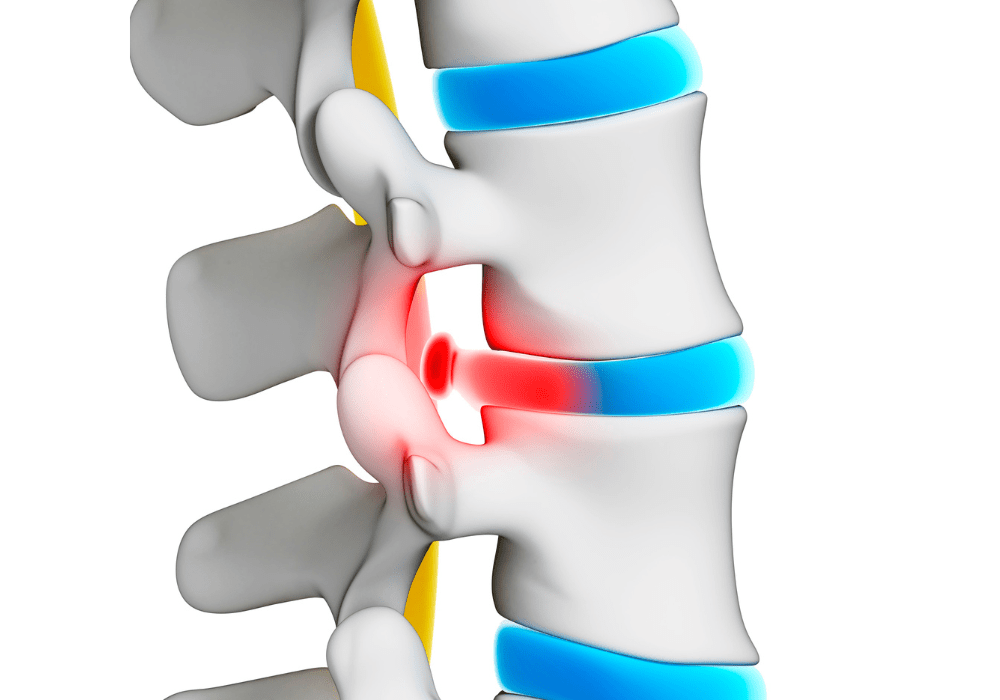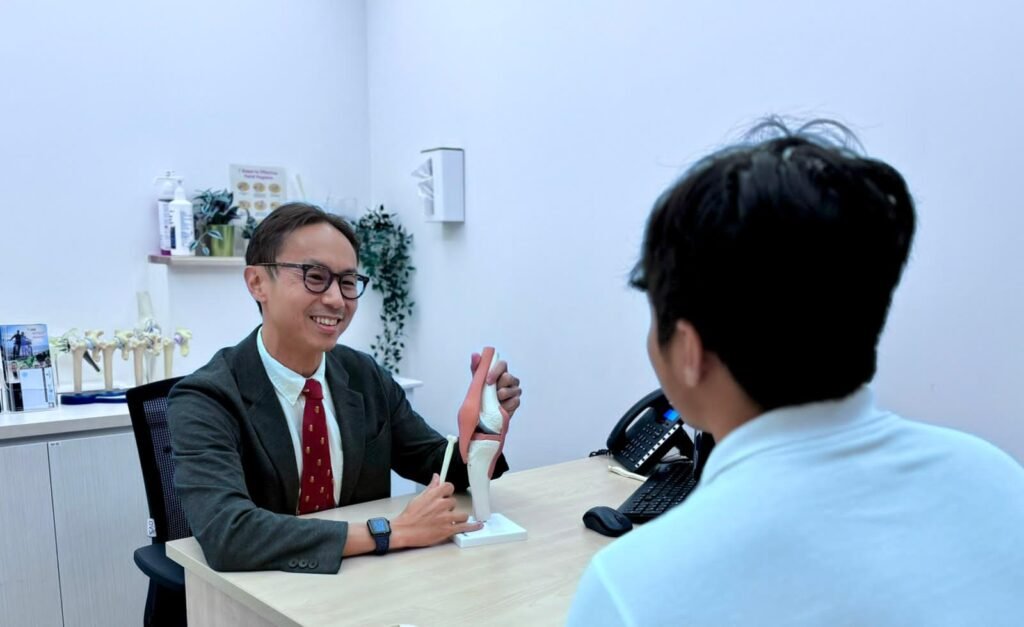Degenerative disc disease Singapore (DDD) is a condition characterized by the gradual degeneration of the intervertebral discs in the spine. These discs act as cushions between the vertebrae, providing flexibility, stability, and shock absorption to the spine. As a person ages, these discs can lose their elasticity, flexibility, and ability to absorb trauma due to wear and tear. Factors such as heredity, smoking, poor posture, repetitive stress injuries, and trauma can accelerate this degeneration process, leading to pain and reduced mobility.

Degenerative disc disease (DDD) is a condition characterized by the gradual degeneration of the intervertebral discs in the spine.
Aging is the primary cause of degenerative disc disease, as intervertebral discs naturally lose water content and elasticity over time, making them more susceptible to damage. Other contributing factors include smoking, which can impair nutrient delivery to the discs, poor posture, genetic predisposition, spinal injuries, and repetitive stress from daily activities or certain occupations. These factors can collectively lead to disc degeneration, causing symptoms such as back pain, weakness, numbness, and reduced flexibility.



The symptoms of degenerative disc disease can vary depending on the location and severity of the disc degeneration. Persistent back pain is one of the most common symptoms, which can range from mild to severe and often worsens with activities such as bending, lifting, or twisting. Pain may also radiate to the hips, thighs, or buttocks. In some cases, nerve irritation or compression due to herniated discs can cause numbness, tingling, or weakness in the legs. Additionally, DDD can lead to stiffness and decreased flexibility in the spine, making everyday activities challenging. Symptoms may fluctuate, appearing and disappearing over time or progressively worsening.
When conservative treatments for degenerative disc disease (DDD) fail to alleviate significant symptoms, surgical intervention may be necessary to stabilize the spine and maintain its function. Two primary surgical options are spinal fusion and artificial disc replacement. Each procedure has specific goals, techniques, and recovery processes designed to address the underlying issues caused by DDD and improve the patient’s quality of life.
Purpose:
The main goal of spinal fusion is to stabilize the spine by permanently joining two or more vertebrae. This procedure is often recommended for patients with severe disc degeneration, spinal instability, or conditions such as spondylolisthesis, where one vertebra slips over another.
Procedure:
During spinal fusion, a surgeon removes the degenerated disc and places bone grafts between the affected vertebrae. These grafts can be taken from the patient’s own body (autografts) or from a donor (allografts). In some cases, synthetic materials may be used to promote bone growth. Metal rods, screws, and plates are often used to hold the vertebrae together while the bone grafts heal and fuse the vertebrae into a single, solid bone. Over time, the bone grafts grow and solidify, providing long-term stability to the spine.
Recovery:
Recovery from spinal fusion involves a period of rest and limited activity to allow the bone grafts to heal. Patients may need to wear a brace to support the spine during this time. Physical therapy is a crucial component of recovery, focusing on restoring strength, flexibility, and range of motion. It can take several months for the bones to fuse completely, and patients must follow their surgeon’s guidelines to ensure a successful outcome.
Benefits and Considerations:
Spinal fusion can significantly reduce pain and improve stability, allowing patients to return to their daily activities. However, because it eliminates movement between the fused vertebrae, it also reduces flexibility in that part of the spine. This limitation is a key consideration, especially for athletes and individuals with physically demanding lifestyles.
Purpose:
Artificial disc replacement aims to relieve pain while maintaining as much natural motion in the spine as possible. This procedure is often considered an alternative to spinal fusion, particularly for younger, active patients who require greater flexibility and mobility.
Procedure:
During artificial disc replacement, the surgeon removes the damaged intervertebral disc and replaces it with an artificial disc made of metal and plastic components. These artificial discs are designed to mimic the function of a natural disc, providing cushioning and allowing for normal motion between the vertebrae. The procedure can be performed on various parts of the spine, including the cervical (neck) and lumbar (lower back) regions.
Recovery:
Recovery from artificial disc replacement is typically faster than from spinal fusion. Patients usually begin walking shortly after the surgery and can start physical therapy within a few weeks. Physical therapy focuses on strengthening the muscles around the spine, improving flexibility, and restoring normal movement patterns. Most patients can return to their normal activities within a few months, although high-impact activities may need to be avoided initially.
Benefits and Considerations:
The primary benefit of artificial disc replacement is the preservation of spinal motion, which can be crucial for maintaining a high quality of life, especially for active individuals. Additionally, the procedure tends to have a quicker recovery time compared to spinal fusion. However, not all patients are candidates for artificial disc replacement. Factors such as the extent of disc degeneration, the presence of spinal instability, and overall health can influence the suitability of this procedure.
Deciding between spinal fusion and artificial disc replacement involves a thorough evaluation by a spine specialist. The decision depends on various factors, including the severity of disc degeneration, the specific symptoms, the patient’s age, activity level, and overall health. Both procedures aim to relieve pain and improve function, but they offer different benefits and have unique considerations.
If surgery becomes necessary, post-surgical management focuses on recovery and rehabilitation:
Pain Management:
Pain control is a primary focus post-surgery. Patients may be prescribed pain medications, with stronger options initially and milder ones as recovery progresses. Non-pharmacological methods like TENS, massage, and ice or heat therapy may also be recommended.
Physical Therapy:
Post-surgical physical therapy is crucial for improving spine strength, flexibility, and mobility. Physical therapists will tailor exercises and techniques to each patient’s recovery timeline and needs.
Wound Care:
Proper wound care is essential to prevent infection and promote healing. Patients will receive guidance on cleaning and drying the surgical wound, monitoring for signs of infection, and adhering to bathing or swimming restrictions.
Follow-up Appointments:
Regular follow-up appointments with the surgeon will ensure proper healing and allow for any necessary adjustments to the treatment plan. Imaging tests like MRIs or X-rays may be used to evaluate the healing process.
Education and Support:
Patients and their caregivers will receive information on what to expect during recovery, potential complications, and strategies to enhance recovery. Emotional support and encouragement are also important to help patients manage the physical and psychological stresses of surgery.
Lifestyle Changes:
Adopting healthy lifestyle habits such as regular exercise, maintaining a healthy weight, and practicing good posture can support spine health and prevent further degeneration.
At our sports clinic, we are dedicated to helping our patients manage degenerative disc disease and return to their active lifestyles. Whether through conservative treatments or surgical interventions, our goal is to provide comprehensive care tailored to each individual’s needs.
Contact us to explore your surgical options and start your journey toward recovery and improved spinal health.
Elevate your performance with Apex Sports Clinic! Schedule an appointment today for personalized, expert care in optimizing your athletic potential.


